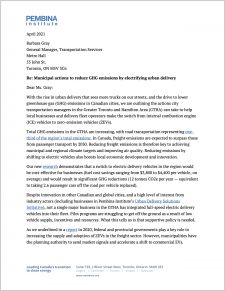
The Pembina Institute has sent the following letter to municipal governments in the Greater Toronto and Hamilton Area (City of Hamilton, Halton Region, Peel Region, City of Toronto, York Region and Durham Region):
With the rise in urban delivery that sees more trucks on our streets, and the drive to lower greenhouse gas (GHG) emissions in Canadian cities, we are outlining the actions city transportation managers in the Greater Toronto and Hamilton Area (GTHA) can take to help local businesses and delivery fleet operators make the switch from internal combustion engine (ICE) vehicles to zero-emission vehicles (ZEVs).
Total GHG emissions in the GTHA are increasing, with road transportation representing one-third of the region’s total emissions. In Canada, freight emissions are expected to surpass those from passenger transport by 2030. Reducing freight emissions is therefore key to achieving municipal and regional climate targets and improving air quality. Reducing emissions by shifting to electric vehicles also boosts local economic development and innovation.
Our new research demonstrates that a switch to electric delivery vehicles in the region would be cost-effective for businesses (fuel cost savings ranging from $3,800 to $4,400 per vehicle, on average) and would result in significant GHG reductions (12 tonnes CO2e per year — equivalent to taking 2.6 passenger cars off the road per vehicle replaced).
Despite innovation in other Canadian and global cities, and a high level of interest from industry actors (including businesses in Pembina Institute’s Urban Delivery Solutions Initiative), not a single major business in the GTHA has integrated full-speed electric delivery vehicles into their fleet. Pilot programs are struggling to get off the ground as a result of low vehicle supply, incentives and resources. What this tells us is that supportive policy is needed.
As we underlined in a report in 2020, federal and provincial governments play a key role in increasing the supply and adoption of ZEVs in the freight sector. However, municipalities have the planning authority to send market signals and accelerate a shift to commercial EVs.
We urge municipalities to:
- Create a targeted commercial ZEV strategy and investment plan. A specific strategy is needed to support the wide adoption of commercial ZEVs. Such strategy should include near and long-term adoption goals.
- Explore and leverage municipal financing tools. A green debenture program could be a way to build out a network of charging infrastructure for municipal EVs, which could also be made available to private entities.
- Regulate commercial parking and loading. Enhanced management and regulations for the curbside can be powerful tools to make more efficient use of the space, decrease congestion and truck idling time and incent the adoption of ZEVs. Examples of regulating commercial parking and loading include giving preferential access to ZEVs, pricing commercial loading zones, and allowing for deliveries during off-peak hours.
- Ensure regional co-ordination on urban freight. A co-ordinated regional approach is needed so that municipalities can share learnings and speed up the adoption of zero-emission commercial vehicles and practices. This should include the use of low-emission zones that restrict the travel of high-polluting vehicles in parts of the region.
- Work with higher orders of government and stakeholders. Engage with industry and civil society stakeholders to advance low-carbon freight initiatives. Encourage federal and provincial governments toward key policies and programs needed to increase the adoption of ZEVs in the freight sector, such as a national ZEV sales standard, financial incentives and investments in labour market programs. Work with energy regulators to explore the creation of a new electricity rate class to help minimize charging costs and ensure electricity grid capacity is sufficient for electrified fleets.
We welcome the opportunity to meet with city staff to discuss the ways in which the GTHA can advance economic and environmental goals, including the shift to electrified urban delivery vehicles.
Carolyn Kim, MCIP RPP
Transportation Director, Pembina Institute
Maddy Ewing
Analyst, Pembina Institute


